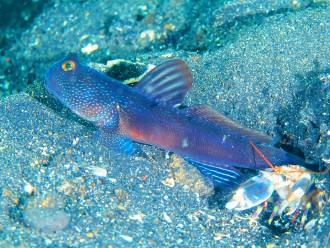Young Scientist: Symbiosis
Young Scientist: Symbiosis
August 20, 2025By AILEEN O'CATHERINE

Deep in the ocean, a shrimp with an amazing grip scurries into its burrow. It has been warned of possible predators by its friend the goby fish, who sits at the burrow opening until a possible predator swims by. At that point, the colorful fish swings around and darts into the small cave where the shrimp already waits, having been alerted by the fish’s presence. It’s a mutually beneficial relationship, a special way of living together for two very different creatures. Shrimp are natural engineers, digging along the ocean floor, stirring up tasty algae that the goby fish then eat. Both benefit from the relationship. In biology, the term for this kind of relationship is mutualistic symbiosis. Symbiosis refers to a close relationship between two dissimilar organisms, or living things. Another example of mutualistic symbiosis occurs when a sea anemone, with its long clusters of tentacles, provides clownfish with shelter and protection from predators. The clownfish, in return, provides the anemone with nutrients through its waste.
Mutualism doesn’t just occur in the ocean, however. When a bee gathers nectar from a flower, its legs attract the flower’s pollen, which it then carries to other flowers, providing the flower with a way to cross-pollinate and reproduce through fertilized seeds. The bees need the flower’s nectar to create honey so they have food to overwinter in the hive. The flowers need to pollinate. Both benefit in this relationship. In mutualistic symbiosis, teamwork is the name of the game.
Another kind of symbiosis occurs when one organism benefits, and the other is unaffected. When cattle wander fields eating grass, their hooves stir up the ground to expose insects, frogs and lizards. Cattle egrets fly down to eat the protein-rich food that the cattle have brought to the surface. The egret benefits from the meal, and the cattle are unaffected by the egrets as they graze nearby. This type of symbiosis is called commensalism.
In the ocean, whales and barnacles have this kind of relationship. Whales travel the oceans in search of food. Barnacles are nature’s version of a hitchhiker. They spawn in the ocean and drift as larvae until they embed themselves on a whale’s skin. As barnacles grow, they form tube-shaped cavities that anchor them to the whale. The whales give the barnacles a safe place to live, a free ride and access to plenty of food. Whales feed on plankton, and barnacles also eat plankton, so a whale’s head or neck is the perfect place for barnacles to spend their time. Even though huge colonies of barnacles can weigh up to 1,000 pounds, the whales hardly feel them. Even smaller whales weigh 55,000 pounds, so the whale is unlikely to feel a few barnacles. Although the barnacles benefit from their relationship with whales, the whales are unaffected by the barnacles. In commensalism, one organism benefits and the other is unharmed.
A third kind of symbiosis occurs when one organism benefits and the other is harmed. This type of symbiosis is called parasitism. When a tick attaches itself to the skin of a host such as a dog, it embeds its mouthparts into the skin. This allows the ticks to hang on while it sucks the dog’s blood for food. The tick may get a full belly, but the dog may get an illness or disease. In parasitism, one organism benefits from the relationship, while the other organism is harmed.
In the natural world, many examples of symbiosis exist. It’s inevitable, as plants and animals, including humans, interact and depend on each other. Some partnerships are surprising, but all make sense in the environment where they live and thrive.

